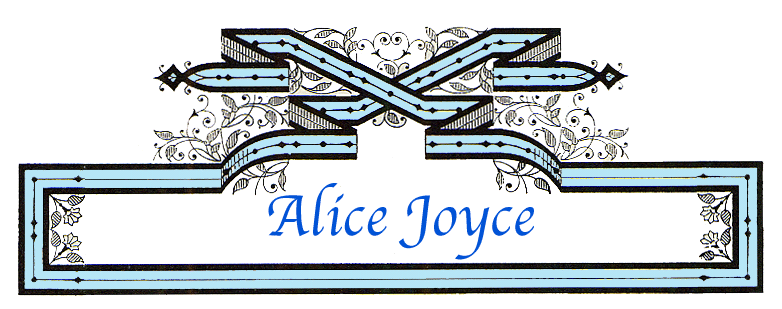

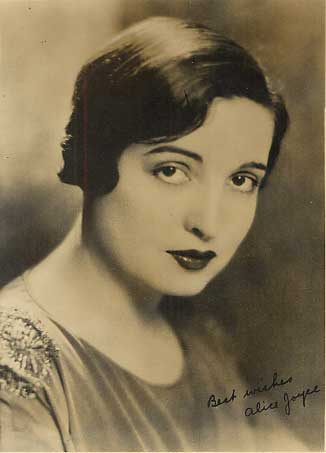 |
|
|
|
Alice Joyce is one of the most striking and unusual stars of the silent screen. She was one of the small handful of stars who were major names from the rise of the star system in the nickelodeon era through the rise of talking pictures. She was not only a beloved star in her own era, but, because of her roles in prestigious films by important directors with major co-stars (and her luck in having those films survive and continue to be shown), she is also a fond and familiar face to the modern generation of silent film fans.
Neither a flapper, an innocent, nor a daredevil, Alice Joyce was an original. A tall, dark-haired women with an unusual beauty, she had an unforced dignity and reserve. Quiet and serene, she had a certain inner strength, and seemed mature for her years. She was gracious and charming, but undemonstrative. She seldom smiled, seldom contorted her features. Instead, when things were going badly as they were wont to do in dramas, she carried a slightly tense or worried expression. Such reticence would seem a disadvantage for an actress, particularly one who relied on silence, but she learned to make her natural demeanor work for her as a performer. When she had to break down and cry, she would often cover her face or turn away, and when an outburst was called for it was short and sudden--and all the more effective for it. But her eyes always spoke volumes and she used her hands with grace. Her style was the polar opposite of an actress like Norma Talmadge, whose animated expressions harmonized with her high-spirited personality. As far as "acting" is concerned, nobody did more with seemingly less than Alice Joyce.
Joyce's career fell into three parts, and we are fortunate that most of her films in her final period of the 1920s survive. During this time she worked in some major films which continue to be shown to this day. But her earlier work for Kalem and Vitagraph companies is more obscure. Only a handful of her Kalem short films survive, and all but one of her Vitagraph films are lost--and that one is locked away as a single negative in a French archive. We are unable to clearly chart the development of her career during her most popular period at the box office. We see her only as a mature performer in her 30s being in a sense typecast by producers who hired her specifically for her special qualities. There would also be interest in seeing her in her youth as a stock company performer in her early Kalem days, and her portrayal of a variety of heroines in her later Kalem series and in her Vitagraph specials and programmers. But from the hints we have from reviews and from the rare Kalem survivors, it appears that her personality was evident from the start--though we can see from The Swindler (1915), that she is also capable of playing a laughing, frivolous young woman when the character requires it.
Joyce was one of the rare silent stars who publicly combined family life with a career. Motherhood became part of her public image, and in most of her later films she plays a mother--often of adult children, parts that were older than her real years. Her own children often appear with her in photo shoots and are usually mentioned in fan magazine articles. Her interviews indicate a somewhat shy but pragmatic woman, with a realistic assessment of her abilities and worth, and refreshingly frank about the value and consequences of a woman's financial independence.
Alice Joyce was born in Kansas City, Missouri, on October 1, 1890. She had a younger brother, Frank. According to the fan magazines, her father, John, was a smelter worker, but her parents separated when the children were young. Census records from her childhood suggest an unstable household.* Her mother worked as a seamstress, but apparently money was tight because by the age of 13 Alice was working as a telephone operator. Business was slow during the summers, so she turned to modeling, and her striking looks soon made her in demand among some of the top commercial artists of the day.
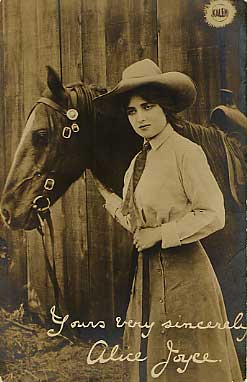 |
|
| Alice Joyce as a western star in a post card issued by Kalem, probably in 1911 or 1912 |
Many models also worked in the new moving picture industry, where the money was better, so Joyce thought she would try her hand. She tried out at Biograph Studios, but unfortunately she did not impress D.W. Griffith, who likened her to a cow. Though mortified a the time, this was a story she enjoyed repeating in her later years. She stuck with her switchboard and modeling work until sometime in 1910. Accounts vary as to the exact circumstances, but it seems that a photographer recommended her to the Kalem Company. Her early filmography is somewhat obscure, and most of the films are lost, making her presence difficult to verify. She remembers her first film as The Engineer's Sweetheart, which was certainly among the first and may have been her first important role. She was asked if she could ride a horse, and she replied that she could, failing to add that her experience was confined to sitting on the back of a farm horse. "I couldn't do it if mother didn't need the money," she later admitted. It was a bruising experience, but the company managers were impressed not only with her looks but with her determination and dogged persistence. She got a bonus for her hard day's work and a contract as a member of the company.
By late 1910 she was being singled out for praise in reviews, particularly in Her Indian Mother, her earliest extant film. Even so early in her career she is already a striking presence on screen, and her natural dignity is a definite asset in Indian roles, of which she had several at this time. Kalem had different film units working in various parts of the country (as well as in Ireland and elsewhere in the world), and when an opening for an ingenue came up in the Glendale company, Joyce was sent to California. The Glendale company, with director Kenean Buel, actors George Melford and Jane Wolfe (joined shortly thereafter by Carlyle Blackwell), specialized in westerns and films about Spanish California and Mexican revolutionaries. The patrician Joyce seems an unlikely western heroine, but she gamely endured Indian raids and gunfights and hijacked locomotives and floursack dresses and poke bonnets. Apparently she had learned to ride a horse by then, for she does a lot of riding. She was rescued from danger by the hero, and in the fashion of many early action films, she sometimes rescued the hero herself. She stayed in California for nearly two years, appearing in a different film nearly every week in parts large and small, and gained a great deal of confidence and poise before the camera.
Kalem was one of the first companies to see the value in advertising its featured players, and Alice Joyce was featured heavily in their publicity. She is mentioned by name in reviews as early as April of 1911. She soon became a well known name and a popular favorite. When Joyce returned to New York in the summer of 1912, she went as Kalem's most popular star, and in her first film after her return to the East, she is featured as herself in a film with baseball great Rube Marquard.
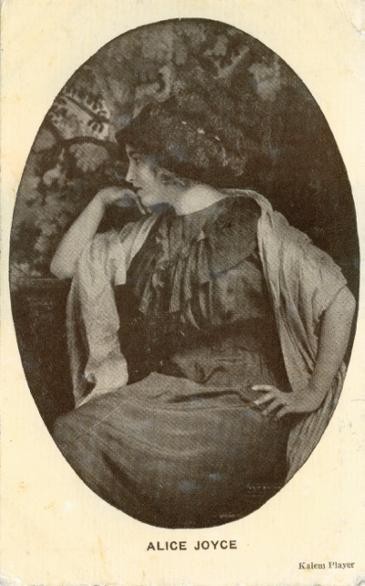 |
|
| Obviously Joyce was a popular postcard subject (Thanks to Mark Goffee for this picture) For another Kalem Postcard of Joyce, click here. (Thanks to Randy Bigham for this scan) |
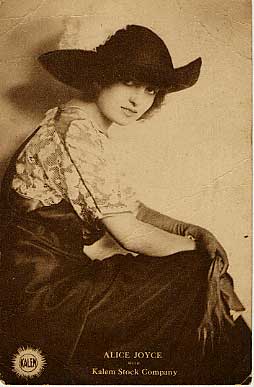 |
|
| A more stylish Joyce from later in her Kalem period. |
In her Eastern films, she left her career as an action heroine behind for the most part and took up residence in her the more genteel surroundings of parlor and drawing room. Her wardrobe definitely improved, and she was even gowned by Lucile on at least two occasions. She played a variety of heroines, from poor street singers to princesses. Her leading man for most of these films was Tom Moore.
Tom Moore was one of a family of well known Irish screen players who were active in American films. Brother Matt, who enjoyed a very long screen career, was about to make a splash in America's first blockbuster feature Traffic in Souls, and brother Owen had worked for Griffith and was secretly married to Mary Pickford. At some point a romance developed between Tom Moore and Joyce, though it's difficult to say when--in contrast to modern publicity, the Kalem Kalendar is remarkably silent on this point. They were married on May 11th, 1914, while on location in Jacksonville, Florida.
Joyce's popularity continued to grow, and in a 1913 poll she was named as the most popular motion picture actress (keeping in mind, however, that the popular Biograph actresses continued to be more or less anonymous). Kalem began experimenting with two and three reel "features" and most of Joyce's films from late 1913 were of this length. In mid 1914, Kalem advertised the "Alice Joyce Series:" two-reel films released every two weeks featuring Joyce. She also starred in two of Kalem's four reel specials from 1914. In mid 1914, Tom Moore was moved to another film unit, with Marguerite Courtot as leading lady, while Joyce was co-starred with Guy Coombs. On April 14, 1915, her last film for Kalem was released. She was off the screen for nearly two years, during which time her daughter, Alice Mary Moore, was born. She later admitted to being restless and morose at home, as well as desirous of being self-supporting, so she determined to return to work.
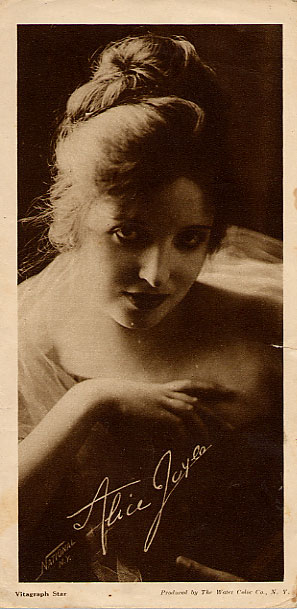 |
|
| A lovely portrait from her Vitagraph days |
During that relatively brief period, there were major changes in the film industry. The longer feature films had taken over the market from the one and two-reelers, and the nickelodeon days were at an end. Features cost much more to produce and market, and many of the old film companies, Kalem among them, decided to call it quits. Tom Moore had gone to work for Arrow Film Company. There is some disagreement over how Joyce came back into films--later accounts say that her contract came to Vitagraph when they bought out Kalem's assets, but contemporary trade journals say that she was shopping around for a new company. In either case, she ended up with a contract at Vitagraph, where she rejoined some of her old Kalem colleagues. She was a major acquisition for Vitagraph, who had already allowed their biggest star Clara Kimball Young, as well as the promising Norma Talmadge to be lured away. J. Stewart Blackton immediately starred her in two of his pet projects, Whom the Gods Destroy (1916), about the Irish insurrection, and Womanhood, the Glory of a Nation (1916), a sequel to his preparedness epic The Battle Cry of Peace (1914).
Joyce played a variety of types of women for Vitagraph, sometimes as conventional heroines, but often as a woman who secretly has a child--and neglects to tell her husband about it. Her biggest starring film was Within the Law (1917), the first film version of that venerable tale. In this she played a criminal mastermind--casting which she found astonishing as did a few of the reviewers. In fact it is clear from several reviews during this early feature period that some people found that her subdued acting style took getting used to. The Spark Divine (1919) cast her in a role which must have been interesting--a woman so repressed that she seems incapable of love. In her later Vitagraph films it seems that she played women whose courage, self sacrifice, or strength of character is able to save the situation. She also added a few light comedies to her repertoire. However, Vitagraph, the last of the old companies, was having increasing difficulty in making quality films and keeping up with the competition. Many of the films seem to have unnecessarily hackneyed plots and by 1921 reviewers complained that they were old fashioned, badly written, and padded to unnecessary length.
The marriage to Tom Moore had not gone well. He is not mentioned in a Photoplay article on Joyce and their daughter in 1917, and by 1918 they seem to have been divorced. Apparently they remained on good terms, however, going to the theater together when in town and both having a hand in raising little Alice. In 1920 she married millionaire James B. Regan, Jr., son of the manager of the old Knickerbocker Hotel. In late 1921, after finishing her Vitagraph contract, she again took a hiatus from the screen. She and her husband traveled to Europe and moved around between his several residences, and during this time another daughter, Margaret (Peggy) Regan, was born.
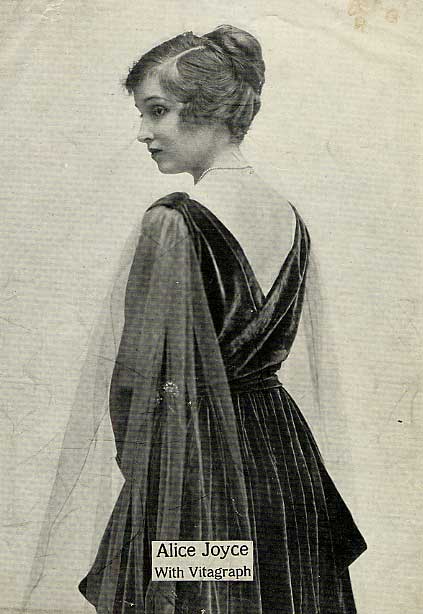 |
|
| Joyce in a Vitagraph publicity photo. This picture also appears on the herald for Within the Law (1917), so perhaps it was a costume from that film. |
Joyce took her time in returning to the screen. Soon after her marriage it was announced that her pictures would be fewer, but better--aiming for quality, not quantity. Now that she was a wealthy woman, she could afford for the first time in her life to be choosy, and she reveled in being able to at last turn down roles she felt were unsuitable. She made a welcome return in The Green Goddess (1923), an excellent tongue-in-cheek thriller with the incomparable George Arliss. The fan magazines welcomed her back. For the rest of her career she freelanced, ably managed by her brother Frank, who had been working in vaudeville and in the hotel business. She traveled to England for her next film, in which she worked with a young Alfred Hitchcock, and, more important for her family connections, costarred Marjorie Daw, wife of Myron Selznick who was involved with the production.
Freelancing can be a dangerous career option, but in Joyce's case it was the best move she could have made. She was in demand by producers and directors when a woman of her special distinction was required, and she was able to land roles in many quality productions. She became a favorite of top director Herbert Brenon, who recognized that her intelligence and class were essential to ensure sympathy for her roles as unconventional women in The Little French Girl (1925) and Dancing Mothers (1926). For Brenon also she was also the aunt whose good name her nephews went to the ends of the Earth to protect in Beau Geste (1926), and the sympathetic companion of the sacrificing father in Sorrell and Son (1927). In Henry King's Stella Dallas (1925) she was the ideal stepmother, into whose hands Stella knew she could place her daughter. James Cruze's Mannequin (1926) finds her cast somewhat against type as a somewhat frivolous young woman whose baby is kidnapped, though here, as in several of her films, she also plays the mother of the grown up child. And who could have made a more ideal fairy princess to rescue W.C. Fields in So's Your Old Man (1926)?
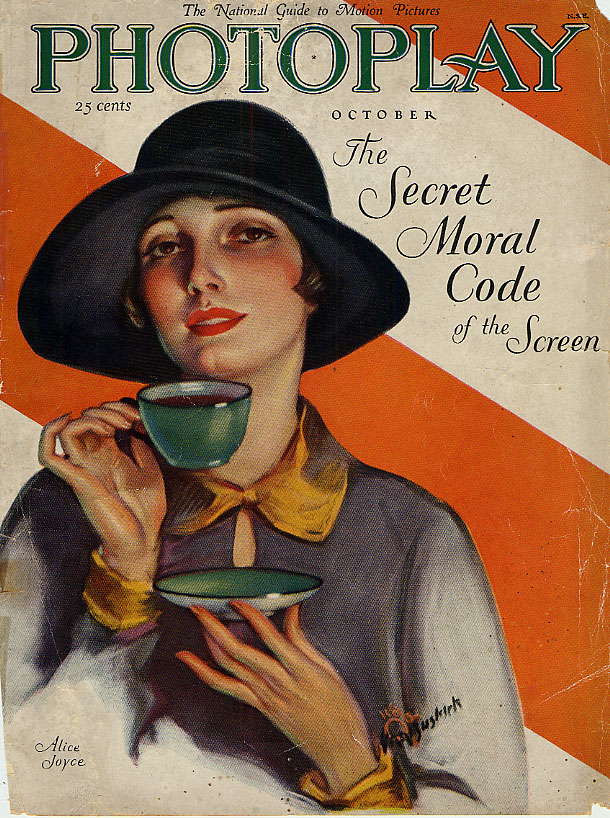 |
|
| A genteel pose with a teacup on the cover of Photoplay, October 1926. |
Little known, but in many ways her most interesting part was in The Home Maker (1925), like Dancing Mothers, a proto-feminist part. From our experiences with later films, one might have expected a more powerhouse type of actress to be assigned with these dramas about strong, independent women--someone perhaps like Pauline Frederick. But in the 1920s, as well as later, these parts could be controversial with audiences, and many could have written off a "strong" actress (a rare type in the 20s anyway) as somehow threatening or unfeminine. But nobody could doubt the femininity of Alice Joyce--even when she was clearly hating every minute of domesticity--and she turned out to be an inspired casting choice.
Not all of her parts were starring ones. In some she was a member of an ensemble cast, and in some she had a key supporting role. As the end of the 20s neared, her starring roles tended to be in lower budgeted films, and the trade journals considered her no longer a box office draw. But she still appeared in smaller parts supporting bigger stars and seemed destined for a future as a character actress. Then the talkie revolution hit and many careers big and small were derailed permanently.
Joyce's first talkie was The Squall (1929), with a promising cast and important director, but the inexperience in sound films of all concerned showed badly. Joyce's voice was as soft and unassuming as one would have expected from her, but she spoke mostly in a monotone in her first talkie. In her last three films she did gain from experience and learn to use her voice more expressively, but she never had a chance to master it as she did her silent acting style. She repeated her role in the talkie version of The Green Goddess, went to Ireland to co-star with the great John McCormack in Song o' My Heart, and finished her career as a straight-woman to Lowell Sherman in He Knew Women (all 1930). Though all of these are interesting films, they were not, with the possible exception of The Green Goddess, major hits. She was a beautiful as ever, but as she was known as a veteran performer and had been playing for several years the mothers of younger actors and actresses, she was probably perceived as older than her 40 years. This is always a difficult time for an actress, and with careers vanishing all around her and a vastly changed picture-making environment, she took the opportunity to retire while still very nearly at the top.
She didn't retire entirely at first. In 1932, she went on a vaudeville tour with ex-husband Tom Moore. Later in the year she filed for divorce from James Regan, and in 1933 married director Clarence Brown. Her daughters were teenagers by now, and she spent much of her time with them. She also traveled in the beginning, but a heart ailment later kept her close to home. Her brother Frank, who had managed her career so successfully, teamed with Myron Selznick to become one of the most powerful and feared talent agencies in Hollywood, Joyce-Selznick, Ltd. Frank died prematurely in 1935 at the height of his career. Daughter Alice Moore had a minor film career in the 1930s, starring in Woman Against the World (1937) for Columbia. Clarence Brown and Tom Moore remained active in films for many years.
Joyce and Brown divorced in 1945, and she moved to Northridge. She was injured in an automobile accident in Van Nuys on June 14, 1946 when a delivery truck hit her station wagon. She suffered a compound fracture of the right leg, face and body cuts, and an injury to her right eye. Clarence Brown went to the hospital and spent hours by her bedside. He also paid all her medical expenses. By the end of 1947 she had almost completely recovered, and made an out of court settlement with the driver and owner.
Though she seldom attended Hollywood social events, she was active in the Northridge Woman's Club, giving reviews of books and plays to the group and hosting events at her home. She took up art, and entered her drawings in local fairs, where she won at least one first place award. Going now by the name Alice Joyce Brown, local newspaper announcements generally mentioned her film career, from which one may infer that she showed justifiable pride in her professional accomplishments. In 1948 she visited Moscow, where her son-in-law and daughter were stationed.
She developed a serious liver ailment in 1954 and was hospitalized, and on October 5, 1955 she succumbed to heart disease. She left her estate of "more than $175,000" to her daughters. She is buried at the San Fernando Mission Cemetery.
Tom Moore had died a few months previously. Their daughter Alice Moore was married to Maj. Nicholas de Tolly, U.S. air attache in Paris at the time of her mother's death, and later married Stanley Miller of the U.S. Information Agency. She passed away in 1960. The wealthy James B. Regan Jr. was in bankruptcy court by 1936, and died in 1939 at the age of 46. Their daughter Peggy Regan was married to screenwriter Ronnie Ferguson, and they were divorced in 1946. She later married a man named Harris and had a son named Steve Harris. She was living in Clark Fork, Idaho in 1955. She later married and divorced a Howard Zellweger and lived in Spokane under the name of Margaret Zellweger. At this time she wrote to the Hollywood Chamber of Commerce to inquire if her mother yet had a star on the Walk of Fame (she apparently still doesn't, though Tom Moore does). I have been unable to trace her any further.
Alice Joyce had one of the most unusual and distinguished careers of the silent film era and remains one of its most distinctive personalities. We are fortunate that so many of her best films have been preserved for the enjoyment of future generations.
* The Kansus Census of 1895 enumerated the Joyce family on Mar. 1, 1895 as follows: Rosedale, Wyandotte County, KS:
The US census of 1900, enumerated the Joyce family on June 20, 1900 as follows: Falls Church, Fairfax County, VA:
By the US Census of 1910, the children were back with their mother, who had remarried. They were enumerated April 15-22 1910, Bronx, NY as follows:
Thanks to Harold Aherne for the census data.
I have no further information on John [Edward?] Joyce, nor on Leon Faber. Her mother died in 1938. Her tombstone at San Fernando Mission Cemetery gives her name as Vallie Olive Joyce, and was apparently erected by Alice's daughters since it calls her "beloved grandmother" and Alice "beloved mother." However, her 1938 LA Times obit gives her name as Mrs. Oline V. Joyce and says she will be interned at Rosedale cemetery.

Special contents © 2003, by Greta de Groat
Last revised December 27, 2015